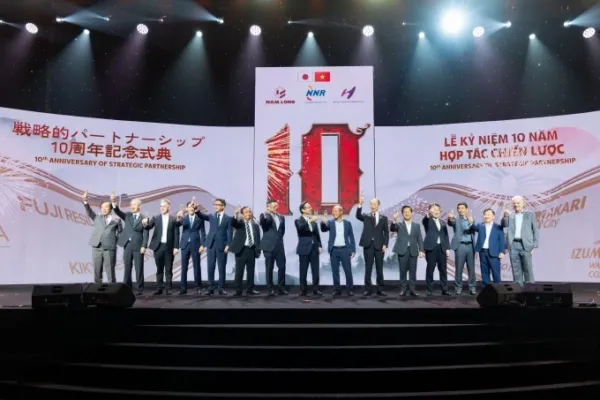
The company, which has grown to more than 800 employees, currently operates 11 urban and residential projects in Ho Chi Minh City, Can Tho, Tay Ninh, and Dong Nai in southern Vietnam and is expanding to the north, providing homes for more than 31,000 families.
According to Nguyen Xuan Quang, Nam Long’s founder and chairman, throughout the group’s 33 years in the market, his greatest aspiration has been to develop “human-centered” cities. To him, this philosophy is reflected in the happiness and smiles of residents, the trust of international partners, and a development principle that remains steadfast despite market fluctuations.
From building houses to shaping urban environments
Nam Long Construction Co., Ltd. was founded on Nov. 16, 1992, in a 28-square-meter office. Quang, an architect, after a decade working at HCMC’s Planning Institute, wanted to create a “professional playground” for his architect peers amid a still-nascent market.
By 1995, transitioning from a subcontractor, Nam Long became one of the first five private real estate companies in Vietnam. During its initial years, the company refrained from following market trends, instead adopting a strategy of “developing housing based on master planning and genuine demand.”
|
Nam Long in its early days. Photo courtesy of Nam Long |
The “Nam Long Homes” program was introduced in 1996, positioning the company as a professional and sustainable developer—its first step in land banking and housing development strategy.
In 2002, Nam Long broke ground on the 28-hectare Nam Long Tan Thuan Dong urban area in former District 7, Ho Chi Minh City, marking a pivotal step toward becoming an urban developer.
In 2005, the company rebranded as Nam Long Investment Corporation, strengthening cooperation with international financial institutions and experienced developers with the aim of delivering large-scale projects.
Three years later, Nam Long advanced its global integration by welcoming two strategic shareholders: Nam Viet Company under Goldman Sachs and ASPL Fund from Malaysia’s Ireka Group, a leading developer. In the following years, it partnered with major financial players, including Mekong Capital’s VAF Fund and IFC under the World Bank.
In 2015, Nam Long expanded its footprint on Vietnam’s real estate map by forming a joint venture with two major Japanese developers—Hankyu Realty (now Hankyu Hanshin Properties) and Nishi-Nippon Railroad, both with 100 years of experience. The Flora Anh Dao project (District 9, HCMC) marked the beginning of this strategic partnership. Since then, numerous Vietnam–Japan urban projects have been built, integrating Japanese expertise with localized designs tailored to Vietnamese lifestyles. According to the company, this blend enables each project to meet international standards while remaining suited to local preferences.
 |
|
Nam Long Group celebrating 10 years of partnership with its Japanese partners. Photo courtesy of Nam Long |
Developing urban townships for genuine housing needs
With a network of international partners, Nam Long expanded its portfolio with numerous Vietnam–Japan projects, including Fuji Residence, Kikyo Residence, Mizuki Park, Akari City (HCMC), Waterpoint (Tay Ninh), and the latest, Izumi City (Dong Nai).
Among them, Mizuki Park spans 26 hectares in Binh Chanh District, Ho Chi Minh City, and is one of the city’s first integrated urban areas, recognized among the “Top 10 most livable urban areas in Vietnam.” Over 70% of the project is dedicated to green spaces and amenities.
In Japanese, “Mizu” means water and “ki” means tree. Surrounded by natural waterways and lush greenery, the township offers a tranquil environment. It is now home to more than 4,000 households and recently started construction on its final compound area, Trellia Cove.
|
A green corner at Mizuki Park in Binh Chanh, HCMC. Photo courtesy of Nam Long |
To the west of HCMC, the 355-hectare integrated Waterpoint township is home to more than 30,000 residents. First conceptualized in 2003, it is surrounded by a 5.8-kilometer riverside. Internally, Waterpoint features an eight-kilometer canal system that regulates the microclimate and shapes a “green-modern-lifestyle” environment.
Waterpoint dedicates 95 hectares to green areas, parks, and open spaces, along with separate jogging and cycling routes inspired by international urban designs that encourage active living and community bonding. It also reserves land for education, commercial centers, cultural facilities, and clubhouses spanning tens of hectares. In July, the Solaria Rise high-rise apartment complex broke ground, rounding out the township’s offerings for young homebuyers.
According to Lucas Loh, Nam Long’s Group CEO, the planning of Waterpoint and all Nam Long-branded townships “places people at the center.” Following its founder’s philosophy, cities must nurture happiness, connection, and a sense of belonging. Therefore, parks, squares, walking routes, waterways, and community spaces form the “DNA” of Nam Long’s developments.
This approach marks a shift from simply providing “housing” to offering a “comprehensive urban lifestyle.” As central areas become congested, lack green space, and face soaring land prices, suburban migration has accelerated.
“Nam Long anticipated this trend and chose to build integrated townships in satellite areas, offering full amenities that allow people to live fully and stay connected with themselves, their families, and their communities,” Loh said.
Nam Long’s philosophy continues at Izumi City, a 170-hectare project to the east of HCMC. With more than 5.5 kilometers of river frontage along the Dong Nai River, an internal water surface of 6.1 hectares, and 20.1 hectares of greenery, Izumi City is designed to balance nature with modern urban living.
Comprising nine zones with more than 10,000 products developed in phases, Izumi City aims to build a stable community with a multi-layered ecosystem of amenities. Recently, the Izumi Canaria low-rise area was approved for sale, offering 461 villas, townhouses, and shophouses expected to diversify the southeastern market.
In Can Tho, Nam Long continues to expand with Nam Long II Central Lake, spanning nearly 44 hectares and featuring planning inspired by the region’s riverside identity.
Recently, Nam Long’s social housing model has been recognized for its effectiveness. The Ministry of Construction named the company among the top 18 reputable social housing developers nationwide. Its chairman Quang was honored by Property Report magazine as “Real Estate Personality of the Year 2025” for his contributions to affordable housing. The company also ranks second among Vietnam’s Top 10 Reputable Real Estate Developers in 2025 (Top 10 Vietnam – Vietnam Report) and fourth among the most valuable real estate brands of 2025 (Brand Finance).
Reflecting on the past, the company says its 33-year journey has been full of ups and downs, yet it has remained committed to its “human-centered urban living” philosophy and to developing genuine products.
“We must ensure that in our projects, no one feels alone. People should feel at home, feel healthy and happy, and step outside with a smile,” Quang said.
-
The story of the mysterious Kavu forests of Kerala, where even today gods reside in the trees.

-
Vietnamese-Finnish couple bridge cultural gaps to build a life together

-
MrBeast unveils ‘Beastland’ theme park in Riyadh

-
Dates Buying Guide: The Quality Check Trick You Must Try This Winter! – Best Tips for Identifying Fresh, High-Quality Khajoor

-
Study Finds Boomers Would Rather Spend Their Money Than Leave Anything For Their Kids
